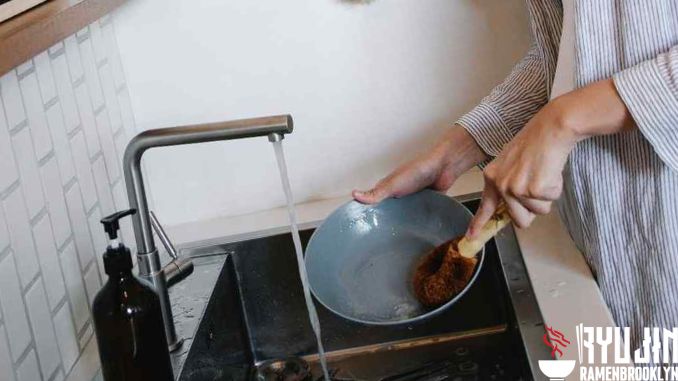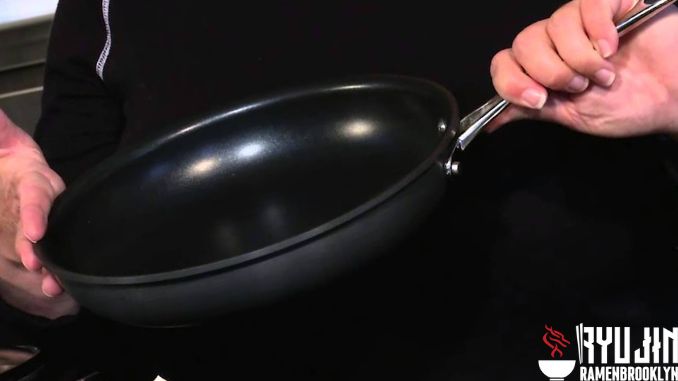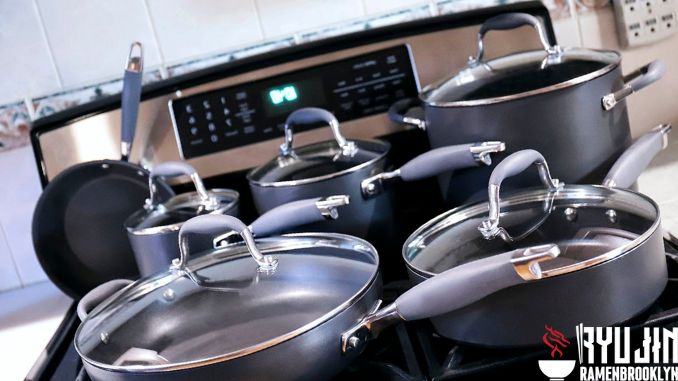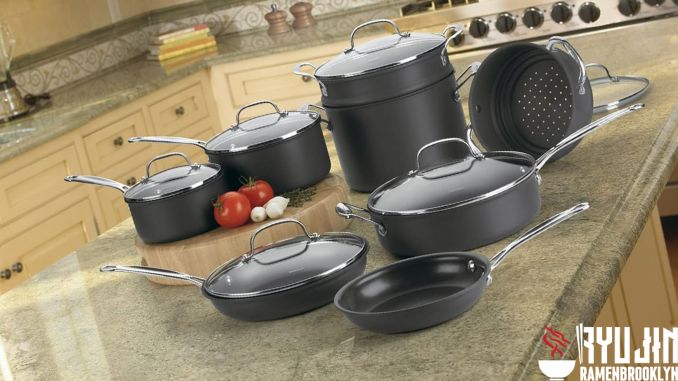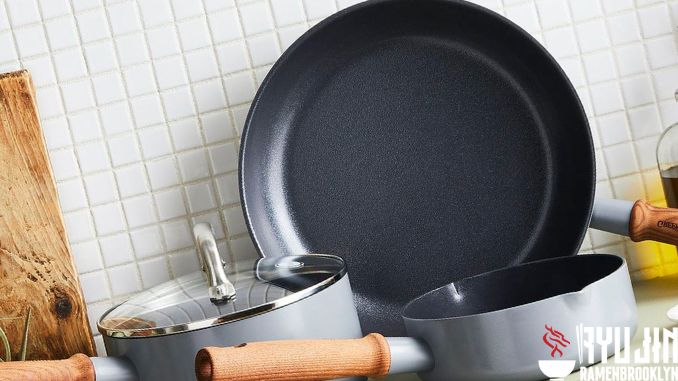How to Clean Hard Anodized Cookware
Cookware is an investment, and like any other investment, it’s important to take care of it, so it lasts. Hard anodized cookware is a popular choice for those who want quality cookware that will last. This cookware is tough and non-reactive, making it a good option for people with allergies or sensitivities.
One great thing about modern hard-anodized pots/pans? They’re much safer than TFE or PTFE because their anodes won’t release dangerous chemicals on the stovetop during cooking sessions. Moreover, they last longer, too, so you can enjoy beautiful gear for years without having to replace anything regularly (or ever).
Anodized cookware is a great option for those looking for an alternative to traditional nonstick. This cookware is made with a hard, non-toxic coating that makes it durable and easy to clean.
But even the best cookware can start to look dingy over time if it isn’t properly cleaned and cared for. If not properly cared for, this cookware can become stained and scratched. You can keep your hard-anodized cookware looking new with care and the right cleaning methods.
Did you know that hard anodized cookware is not dishwasher safe? You will need to use a few simple tools and supplies to clean your cookware properly. This blog post will discuss the best way to clean your hard anodized cookware. We will also provide some useful tips for keeping your cookware in good condition. Keep reading to learn more!
What is Hard Anodized Cookware?
Anodizing is a process of preventing natural corrosion by oxidizing the metal. For example, in cookware, an aluminum pan goes through this transformation to create its layer about 5 nm thick – making it extremely high resistance to metal particles and other substances which would otherwise cause discoloration or damage over time due to chemical reactions with food molecules!
In cookware, anodes are used on all types and grades to produce durable surfaces and non-porousness, which gives some durability when compared with other materials such as stainless steel or cast iron.
Hard anodized cookware is made with a process that makes the metal harder and more durable. First, the cookware is dipped in an acid bath, which causes a chemical reaction that changes the structure of the metal. This process makes the cookware more resistant to scratching, chipping, and corrosion.
The hard anodized finish also makes the cookware non-reactive, so it is a good choice for people with allergies or sensitivities. Hard anodized cookware is also a good choice for those who want to avoid using nonstick cookware. Nonstick cookware can release harmful toxins when heated, but hard anodized cookware is safe.
Hard-anodized aluminum cookware is the best type of pan you can buy because they’re durable and designed to last. Unlike other types, hard anodic metals don’t react with food orScores affective materials in any way; your expensive pots will never rust through! In addition, these utensils are resistant to corrosion and can withstand high temperatures without denting easily, unlike softer metals such as stainless steel, which typically shatter at temperature changes.
These durable metals can withstand high temperatures, making them great choices when cooking with fire or electricity! Many often have a concern about these types of cookware is whether they will get into your food while using. However, there’s no chance this could happen thanks to an effective process known as “anodic coating.”
How does hard-coating work? Applying a layer on top of other materials (in this case, Lodge Cooper stainless steel goes onto both sides) so that no harmful chemicals come into contact with your cooking. This is how you can be sure your food will taste great and be safe to consume!
Hard-anodized aluminum cookware is not designed for dishwashers and should be hand washed. Experts recommend that you use a soft cloth or sponge to gently clean your pans because harsh scrubbing can damage the surface of these cooking utensils over time, leading to ware performance issues such as scratches on surfaces which will then lose their shine due to corrosion from metal tools used during the cleaning process.
See more: Is Anodized Cookware Safe?
What are The Benefits of Hard-Anodized Cookware?
Hard-anodized aluminum cookware is the perfect material for those looking to invest their money into something that will last. It’s easy enough that even an average person can take care of it. In addition, its low price point makes this option more affordable than other more expensive materials like copper or steel, which may be difficult if not impossible to find in some cases altogether!
In addition, aluminum is one of the best materials to cook with because it heats up quickly and evenly. This means your food will cook more evenly, and you won’t have to worry about hotspots where certain areas are overcooked while others remain undercooked.
This cookware is also non-reactive, so it’s a great choice for people with allergies or sensitivities. Hard anodized cookware is also a good choice for those who want to avoid using nonstick cookware. Nonstick cookware can release harmful toxins when heated, but hard anodized cookware is safe.
Health-wise, the benefits of hard-anodized cookware are huge. Unlike PTFE and Teflon style nonstick coatings that release harmful chemicals into your food when heated up, which can cause cancer or other health issues down the line. Aluminum does not do this, so it’s healthier for you!
Hard-anodized cookware is strong, durable, and lightweight. They’re also safe to use on any type of stove, including induction! Not only do these pots/pans resist chipping or breaking, but they don’t stain easily as some other materials can, so you’ll never have trouble getting rid of food odors from your stainless steel fridge door again because hard anodes repel acids while conducting heat away quickly with no risk whatsoever in leaching chemicals into its surface during heated sessions, unlike other cheaper options out there.
If you look after the cookware, they’ll last a lifetime. If you don’t, they may not last as long as some other materials, but they should still give you years of service. With proper care, hard-anodized aluminum cookware will last longer than any other type of pot on the market today!
How to Clean Hard Anodized Cookware
Hard anodized aluminum can last for years with proper care and maintenance. However, to keep your hard-anodic cookware in pristine condition, avoid using metal utensils or cleaning products on them, as this will cause scratches that may lead to rusting, which is against their durability!
There are several steps in cleaning hard-anodic metal utensils properly, so they don’t wear out quickly and develop rusting or other damage easily!
Choose Your Products Carefully
Choose your favorite cleaning products wisely, as harsh detergents can damage the surface, and soft sponges will scratch their finish over time (not to mention this might be a problem if you want some of that nice looking).
Start by removing all germs with soap or disinfectant before using an abrasive agent such as steel wool which could also meditate porcelain enameled cast iron skillets! Use heavy-duty nonabrasive cleaners inside each vessel first, then give them another thorough rinse outside where bacteria loves hanging out because nothing likes living on top better than crumbs do.
Hard-anodized cookware is a type of cookware that has been coated with an aluminum panning which makes them non-reactive, durable, and easy to clean. If you do need some extra elbow grease for those stubborn stains, try brushing on the inside using soft bristles from time to time before rinsing out with warm water as usual.
If everything fails, then there’s always good old-fashioned soap & water – just make sure never to soak hard metals in liquid due to the overwhelming corrosion effects that’ll take place!
Clean Your Cookware
Hard anodized cookware is durable and will last a long time, but it can get dirty quickly. To keep your pots looking their best after cooking with them for years to come, give them a quick wipe-down when they’re done so as not to soil other dishes or surfaces! It’s important that hard-an Elysian recipes only seasoning once it’s cooled down; otherwise, there could be scratching on the surface, which would ruin its good looks forever!
This means running under warm tap water before cleaning using dishwashing soap & sponge; if food gets stuck – use the scouring side of the sponge with little pressure in a circular motion. If there’s no improvement, then the boiling water method could do the trick (boil inside the pot for 10 minutes, then empty out) or leave overnight with a tablespoon of baking soda before rinsing it off completely in the morning.
If your cookware looks dull, use a polishing agent such as Bar Keepers Friend to clean and shine them up! Just remember that using abrasive materials on the surface will eventually wear down hard-anodized aluminum if done too frequently, so be sure only to do this when necessary.
You can also use white vinegar or lemon juice to get rid of any stubborn stains but rinse immediately afterward with water as these acidic solutions will cause corrosion over time if left on the metal surface.
If food is cooked on high heat, it can cause the formation of a hard crust that’s difficult to remove. So, before cleaning, ensure to soak your cookware in hot water for at least 30 minutes to loosen the crust. You can also use a nonabrasive cleaner and a nylon scrubber to help remove any stubborn stains.
Once you’ve removed the tough stuff, give your cookware a final rinse with warm water and mild soap. Finally, dry it off completely with a soft dish towel or let it air-dry before putting it away.
Have you ever had something seriously burnt on the bottom or sides of your anodized pan? Cover it in baking soda and water overnight before washing out with soap. Don’t use steel wool, metal utensils (including wooden spoons), or commercial cleaners like Mrs. Meyers Clean Day™ – they’ll damage delicate cooking surfaces even more than usual!
Here are the steps to clean hard anodized cookware:
Allow Cookware to Cool
You should always let your cookware cool before washing. This step is critical for both safety and physics, as the metal expands or contracts to depend on its current state in temperature changes; if you rapidly lower the amount of energy that it’s exposed to when overheated, this can lead not only to warping but even more importantly – breaking- apart at any given time!
Such risks may be less pronounced on hard anodized pots/pans (though certainly still present). However, an excess exposure would inevitably cause cracking, which might result in leaching chemicals used during the anodization process – not good for your food!
Rinse With Warm or Hot Water
Adding hot or warm water and incorporating some liquid dishwashing soap is the key to washing your pans. This will help eliminate any food that may be stuck on the cooking surface while also allowing you more time before having to clean it by hand!
Make sure not ever rinse with cold because this can cause fats in dishes to solidify, causing them to become waterproof, which makes removal much harder without scratching away at precious metals below.
Soak With Baking Soda Overnight (Can Do or Not)
Baking soda is the best way to get rid of burnt food stuck on your cookware. Just make sure you never mix the two because it will only create more smoke and fizz, not help!
To just liberally cover any part that has been burned up using water – always be careful around edges as they may still burn easily due to their proximity near open flame sources such as gas stoves or oven doors where heat might escape faster than elsewhere within a kitchen space.
After the baking soda has been applied, let it sit overnight so the mixture can work its way into any hard-to-reach places where caked-on food might be hiding.
Rub Cookware Down With a Sponge and Soap
Cleaning your favorite pan is a lot easier than you might think! First, apply soap to the sponge rather than directly onto the cookware. This will prevent overestimating how much washing-up liquid or other cleaners are needed and also protect against accidentally washing any of those products off under running water (which can be tricky).
Make sure that when using baking soda as step 3’s method for removing stubborn stains from nonstick surfaces – like oil-based ones–you use only enough, so it doesn’t fizz up immediately; too much force may cause damage due to its chemical reaction with metal utensils nearby.
If some areas still seem to have food residue, you can use a nylon scrubber. Be sure to rub in the same direction as the grain of the cookware so that you don’t end up scratching it.
For more thorough cleaning, you can soak your cookware in a solution of 1 part vinegar and 3 parts water for a few minutes. Then, scrub the area with a soft sponge or cloth and rinse with warm water. Dry thoroughly.
You can also use a nonabrasive cleaner specifically designed for hard-anodized cookware. Follow the directions on the cleaner to ensure that you’re using it correctly.
You can use a gentle detergent for their exteriors without worrying about losing color or shine by cleaning it gently, but don’t forget nonabrasive sponges (like nylon) when scrubbing tough stains! Powder cleaners work on the molecule level, so they’re perfect for removing stubborn marks left behind after cooking with olive oil or burnt food–just make sure you wear gloves because these chemicals will burn skin easily if touched directly without protection.
If your cookware has a lot of buildups, you can boil water in it and then use a wooden spoon to scrape off the residue. Be sure to do this carefully, so you don’t damage the cookware. Rinse with warm water and dry thoroughly.
For hard-anodized cookware, you can also use white vinegar or lemon juice as a natural degreaser. Simply apply the vinegar or lemon juice to a soft cloth and rub it onto the cookware’s surface. Rinse with warm water and dry thoroughly.
No matter your chosen method, rinse your cookware thoroughly with warm water to remove any soap residue. Dry it completely with a soft cloth before storing
Rinse With Warm or Hot Water
After scrubbing, rinse your pan with warm or hot water. You want to ensure that all of the soap is removed from the cookware’s surface, as this can cause problems when cooking with it later on.
If any stubborn pieces of food remain, you can soak your pan in hot water for a few minutes before trying to scrub it again.
Dry Thoroughly & Immediately
Once you’re done cleaning, dry the cookware completely and immediately. If water is left on the surface, it can cause spots or streaks. You can use a clean cloth or paper towels to dry the cookware.
Though aluminum doesn’t “rust” like steel, tap water contains a bunch of other junk you don’t necessarily want sitting in your pan. You can dry clean this type of cookware by using a soft cloth or letting it hang out until its time to be cleaned again before washing right away with fresh water and then drying upside down, so the accumulated residue falls off while waiting for all those pesky oils from cooking foods such as chicken fried rice which love living life on top!
To avoid any water spots, you can also put the cookware in a low oven for about 20 minutes to help evaporate any water that may be remaining on the surface.
You may notice some mineral deposits on your cookware if you have hard water. These can usually be removed with vinegar or lemon juice. Simply apply either of these acidic liquids to a clean cloth and rub it over the affected areas. Rinse the cookware well afterward to remove any residue.
Stubborn Stains and Residue
If you’re dealing with some tough cooked-on food, don’t fret! There are a few ways to make your anodized aluminum cookware look as good as new again without any harmful chemicals.
One way is to make a paste using 1 part baking soda and 3 parts water. Rub the paste onto the stain using a soft sponge or cloth in a circular motion. Rinse the area with warm water and dry thoroughly.
Another way to remove stubborn stains is to boil water in the pan and let it cool for a few minutes before scrubbing with a soft sponge or cloth. You can add a little vinegar to the water for extra cleaning power. Rinse the area with warm water and dry thoroughly.
If you have any tough residue clinging to your anodized cookware, try soaking it in a solution of 1 part vinegar and 3 parts water for a few minutes. Then, scrub the area with a soft sponge or cloth and rinse with warm water. Dry thoroughly.
Cleaning Your Cookware Regularly
It’s important to clean your hard-anodized cookware regularly to prevent staining and buildup of residue. After each use, wash your cookware in hot, soapy water and dry thoroughly. If you notice any stains or residue, use one of the methods above to clean it up.
Things to Avoid When Cleaning Hard Anodized Cookware
When storing your pot, place the lid upside down on top of it. This will help prevent any odor from building up and ruining its new look! There are also some other things you should keep in mind so that these pots continue looking fresh for years into the future – remember not too steep or rinse them when getting ready to cook with one since both actions could damage hard-anodized aluminum surfaces if done incorrectly.
Put in The Dishwasher
The dishwasher is not always ideal for putting your pans, especially if you have hard-anodized pots. Some brands will say they’re safe, but there is a consensus that it’ll shorten their lifespan.
The detergent used in these machines can be harsh and add on top of that temperature from the hot water coming out while inside a cabinet where there’s no ventilation system set up for ventilation purposes! This high-level chemical exposure could damage both nonstick coatings as well as lead to other problems such as peeling off or chipping away chips which would then make burnt food more likely due prone to being stuck together by proteins bonding too quickly after heating over time since they don’t get cooked fully during cooking processes.
It’s best to hand-wash your anodized cookware with warm, soapy water and dry it thoroughly. If you choose to put it in the dishwasher, use a gentle cycle and avoid using harsh detergents. Inspect your cookware after washing it in the dishwasher to ensure there is no damage.
Using the Wrong Cleaner
Using the wrong kind of cleaner can be dangerous to your pots and pans, not just because it might scratch their coating but also due to the chemicals in those cleaners. For example, bleach has been known as an etching agent for aluminum, so if you used one on these materials, some serious stains would likely come away—not only does this make them look bad now.
It’s best not to use products that contain chemicals like bleach or oven cleaner because they can etch into the surface of your pots, making them look dull and damaging nutrients in the fish sauce, which creates bad-tasting food! Abrasive cleaners also have no place on delicate metal utensils where even seasoned coating may be worn away after just one use.
Instead, try low-pressure washes with dish soap followed by hot water – this way, you’ll only get rid of dirt without getting any chunks stuck inside those cracks where food goes when cooking at home.
Put Hot Pans in Cold Water
To prevent your pots from warping, it’s best to let them cool down before you attempt cleaning. If they are too hot and put into cold water, this will cause a warp that cannot be fixed or repaired- irreparable!
To soothe an overheated pan, I would recommend boiling some fresh tapwater in another vessel and then adding that same amount of heated liquid onto the cookware’s surface; making sure not to fill any higher than 2/3rds full since overfilled containers have been known to contribute further damage due to excessive heating while submerged under these conditions. After a few minutes, the water should’ve cooled down enough where touching it won’t cause any drastic changes, so go ahead and proceed with your normal cleaning routine!
FAQs
How to Clean Burnt Anodized Pans
The easiest way to clean burnt food from anodized pans is by using hot water, dish soap, or volatile chemicals like bleach. If that doesn’t work, you can use nonabrasive cleaners such as nylon or wire wool pads with gentle pressure for dishes made from aluminum alloys; these will not scratch the surface so long as they’re applied carefully!
Finally, there’s always boiling water plus vinegar: put your pot onto low heat until its covered—don’t leave it unattended near open flame because accidents happen easily when we aren’t paying attention – then add 1 part white wine/vinegar ratio into 10 parts cool water, let it come to a boil before removing from heat to cool down.
After 30 minutes, use a nonabrasive pad or brush in gentle circular motions across the entire surface area (being careful not to press too hard), and voila! Your pan should look as good as new.
You can also use baking soda to clean burnt anodized pans. The first thing you need to do before trying any solution or technique for cleaning this cooking equipment is scrub down the surface with baking soda and water, followed by warm soapy washes to break up physical bonds between residue on metal parts of your pan that could lead into more severe problems later if left unattended.
Baking soda is a great way to eliminate stubborn burnt food stains because it will turn any oils or fats in the unwanted residue into soap. This changes how physical appearance looks and makes removal much easier than if you were trying to save your dishware by using other methods!
Baking Soda mixed makes a great paste that removes tough stains like grease from griddles without scratching their finish – just make sure there’s enough moisture available (not too much, though) because dryness will cause crystals formation when applied directly onto glossy surfaces.
Once you’re done cleaning, rinse the area with cool water to remove any leftover residue and dry it off with a soft cloth or paper towel.
The science behind making baking soda bombs is really interesting. You can use it as a chemical reaction to cleansing your kitchen, but be careful when applying the vinegar because if you do so immediately after mixing them, there will just be fizzy water instead! On the other hand, letting these powders sit for a while before washing away does wonders–you’ll have pleased recipe readers who want their homes cleaned without chemicals smelling awful all over everything in sight.
Can You Restore Hard Anodized Cookware?
There is no external coating on top of the anodized cookware, so it’s theoretically possible to re-anode. But, let me get this straight: unless you have a lot of experience and equipment for acid baths with controlled electrical currents–no one at home will be doing this either!
Yet anodized cookware is still cheaper than ceramic, so you may as well just throw away any damaged pieces. The value proposition of this type o product lies in its price point – but even though it can be re-anodized to some degree and still function, 1:1 correspondence will never happen because every dent or ridge stands out more now, unlike before, where flat surfaces.
See more: How to Anodize Aluminum
Conclusion
Hard anodized cookware is a great way to get nonstick surfaces’ benefits without all the chemicals. It’s also more durable than traditional pots and pans, so you won’t have to replace them often. However, because it doesn’t have a protective coating, it can be difficult to clean if you don’t know how.
In this article, we’ve gone over how to clean hard anodized cookware so that you can keep your pots and pans looking new. We’ve also talked about how you can restore hard anodized cookware if it becomes damaged.
Nothing is worse than buying a new pot and having it last only two years. You may need to replace them constantly, not because they wear out but because of the high expense of these cooking pieces! But now that we know how easy cleaning hard-anodized pans can be done by following some simple steps, there’s no reason why we can’t make them last much longer.
So the next time you’re wondering how to clean hard anodized cookware, remember the steps we’ve gone over in this article, and you’ll be able to keep your pots and pans looking new for years to come.
If you have any questions or concerns, contact the manufacturer of your anodized cookware set for further instructions on properly maintaining their products. Check out our website if you want more useful information to complete your kitchen collection. Thanks for reading, and happy cooking!
Anthony Michelin (March 26, 1960) is the CEO of Ryujinramenbrooklyn.com – is an expert in finding specialized equipment to assist in the Bar & Kitchen sector. With over 40 years of focus on finding the simplest recipes on the most suitable cookware to create the most delicious meals, I believe it will help you.
